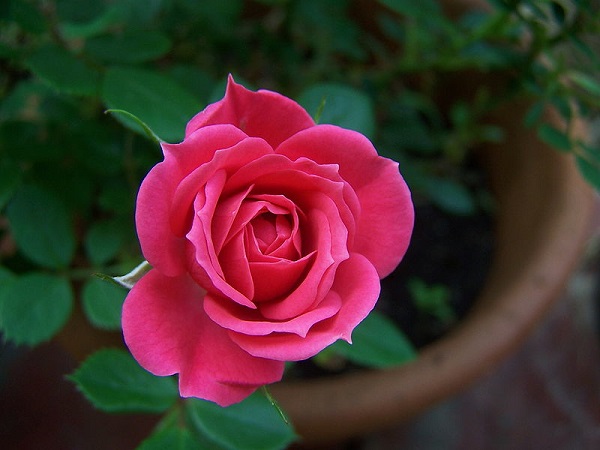Miniature Roses (R. chinensis minima) are beautiful little plants, hybrids that trace their parents back to China, usually appear in stores around Valentine’s Day and Mother’s Day. They look lovely when first purchased but are difficult to keep indoors on a permanent basis. Enjoy them for a while in your home and then put them outside as soon as the weather permits. They will grow much better outdoors in the fresh air and bright light. A Miniature Rose produces small flowers about 1”-2” in size in a variety of colors such as red, yellow, pink, white, peach, and orange. Just like the regular outdoor rose, some miniature roses are bushes while others are climbers. Since this plant is a hybrid of the regular rose, it needs the same type of care and attention.

Care
Light: A Miniature Rose needs very bright light in order to grow. If you don’t have a place where it will get several hours of direct sunlight, try moving it outdoors into the direct sun for a while each day once the danger of a frost is over. When there is insufficient light, Miniature Roses don’t bloom, the stems start to stretch, and the plant becomes thin.
Water: Miniature Roses require a great deal of water, especially when they are flowering. Since these plants are usually purchased in a small pot, be sure to check the soil every few days. Allow the top 1” of soil to dry out before watering. During the winter, when a Miniature Rose is resting, keep the soil barely moist. Be careful not to get water on the leaves since this causes a fungus called Black Spot.
Fertilizer: Feed a Miniature Rose every two weeks in the spring and summer when it is actively growing. Use a fertilizer that is high in phosphorous (5-10-5) at ½ the recommended strength.
Humidity: Miniature Roses need moderate to high humidity. If your home is dry, especially in the winter, place a Miniature Rose on a tray of wet pebbles. Be sure the plant is sitting on the pebbles and not in the water.
Temperature: Miniature Roses do well in temperatures between 60-75 degrees. Roses in containers are very susceptible to frost.
Pot: If your Miniature Rose has more than one plant in the pot, gently separate the roots of the plants and put them into their own separate containers. Use as much of the original soil as possible and be sure that all pots have proper drainage holes. If the pot of a Miniature Rose is too large, the plant will not grow.
Soil: Use any good basic organic potting soil that drains well. The ph of the soil should be neutral.
Pruning: As a Miniature Rose matures, remove dead branches and any branches that are rubbing against each other. After the plant has finished blooming in the fall, prune it back; this encourages new growth for the next season. Prune the branches about ¼” above a leaf axel.
Flowers: Remove dead blooms as soon as they appear, this encourages the plant to bloom for a longer time. Always use a sharp pruner or scissors to cut the flowers off, never just pull them off with your fingers. Tearing the stems, rather than cutting them at a 45-degree angle, damages the stem and encourages diseases. Once the plant finishes blooming and the weather warms up, move your Miniature Rose outdoors. Be sure to bring it back inside once the temperature goes below freezing.
Propagation: Propagate Miniature Roses by stem tip cuttings in the early summer. Use about a 4” piece, dip the end in rooting hormone, and plant it in a small pot of moist potting soil. Try placing the plant in a clear plastic bag to increase the humidity while it is rooting.
Pest: Spider mite and mealy bugs may infest a Miniature Rose grown indoors. Rinse the plant once a week with mild soapy water solution to help prevent infestations and keep the plant dust-free.
Diseases: If kept too damp, Miniature Roses, like their bigger cousins, develop a fungus called Black Spot. Immediately remove the infected leaves and treat the plant with a fungicide recommended for Black Spot.
Toxicity: Non-toxic
4 Frequently Asked Questions
1. Why do the flower buds on my Miniature Rose shrivel up and die before opening?
This is probably because the air in your home is too dry. Place your plant on a tray of wet pebbles or next to a humidifier to increase the humidity around it. If the weather is warm enough, move it outside.
2. My Miniature Rose has never bloomed since I first bought it. It just looks skinnier and uglier. What am I doing wrong?
Your Miniature Rose needs much more direct sunlight. This plant quickly deteriorates when it is not getting enough very bright light.
3. Why are there are black spots on the leaves of my Miniature Rose? I keep washing the leaves hoping to get rid of whatever it is, but it just keeps getting worse.
The plant has a fungus called Black Spot and washing the leaves just makes it worse. Remove the infected leaves, keep the rest of the leaves dry, decrease the humidity if possible, and spray the plant with a fungicide made for Black Spot.
4. My Miniature Rose keeps getting yellow leaves. What should I do?
Not enough water, not enough sun, or not enough humidity may cause yellow leaves. Also, Miniature Roses, like regular roses, become dormant for a few months and lose their leaves during this period.
Judy Feldstein is the founder of Foliage Unlimited, one of the largest interior plant design, sales, & maintenance companies in Arizona. After selling the company, Judy developed an indoor plant care website Houseplant411.com.
Related Articles & Free Email Newsletter
Increasing the Lifespan of a Succulent Plant




Comment here